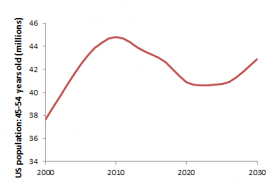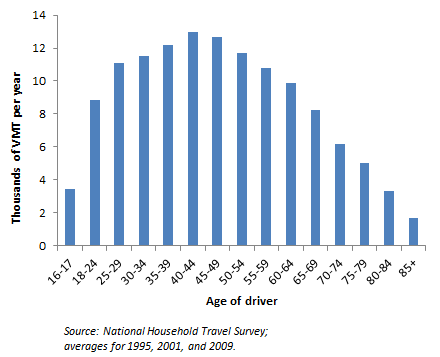You’ve probably heard of Peak Oil, and maybe even Peak Fish. But have you heard of “Peak Middle Aged People”?
 That’s right, the Census projects that the aging of the baby boomers is sending the population of 45-to-54 year-olds in the United States into reverse. In fact, that age group reached its near-term peak in 2010. Even as the overall population is expected to grow, we’ll actually have fewer 45-54 year olds in 2030 than we do today.
That’s right, the Census projects that the aging of the baby boomers is sending the population of 45-to-54 year-olds in the United States into reverse. In fact, that age group reached its near-term peak in 2010. Even as the overall population is expected to grow, we’ll actually have fewer 45-54 year olds in 2030 than we do today.
This demographic shift will almost certainly affect driving trends. According to each of the last three National Household Transportation Surveys, driving peaks in middle age. At age 54, you drive about as much as you did in your late twenties and early thirties…but after that, it’s a long, steady decline. Take a look at this chart of Vehicle Miles Traveled by drivers’ age:
This makes intuitive sense: folks in middle age are near the height of their earning power, are particularly likely to own a car, and often have demands from work or kids that boost their driving. But as people grow older, they’re more likely to retire, and less likely to have to schlep the kids to soccer practice.
But remember, the boomers are a particularly large generation—that’s why they called it a baby boom, after all—so trends among the boomers are likely to have an outsized impact on national averages. And that includes average driving.
To make matters more interesting, right on the heels of the boomers is the much smaller baby “bust” generation, born when fertility rates were falling to post-war lows. The “buster” demographic is currently moving through its peak driving years, but won’t completely fall off the VMT cliff until about 2030.
All else being equal, these two demographic shifts–aging boomers, rising busters—will lead to an overall decline in per-capita vehicle travel. And the aging of the boomers in particular is likely to influence driving trends for the next two decades. In fact, based on Census population projections and National Household Travel Survey data, we expect per capita driving for the adult population of the United States to fall by 6.5 percent through 2030.
That estimate is based on demographic shifts alone. It doesn’t factor in the other trends that may affect driving; shifts in gas prices, blips in birth rates, changes in social values, new patterns of land use, improvements in mobile technologies, and the pace of economic recovery will all affect our propensity to get behind the wheel. Combined, these other forces may overwhelm the demographic shifts. So take these VMT projections as provisional: all else being equal, we expect per capita driving to fall, but it’s seldom true that all else really is equal.
Still, it’s worth remembering: any VMT projection that doesn’t account for the aging of the boomers is missing an important piece of the story.
Sources:
US Department of Transportation, Federal Highway Administration, 2009 National Household Travel Survey. URL: http://nhts.ornl.gov.
US Census Bureau, Population Division, 2030 Population Projection, http://www.census.gov/population/www/projections/files/DownldFile2.xls



Comments are closed.